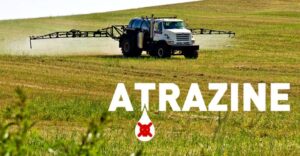44 Countries Banned or Are Phasing Out Atrazine. But the U.S. Just Keeps Spraying.
A trove of well-documented research links atrazine, an endocrine-disrupting weedkiller, to birth defects, low sperm counts and fertility problems, but the U.S. Environmental Protection Agency continues to allow its use.
 Independent scientists have long understood the unacceptable health risks of the pesticide atrazine.
Independent scientists have long understood the unacceptable health risks of the pesticide atrazine.
A trove of well-documented research has linked the endocrine-disrupting weedkiller to birth defects, low sperm counts and fertility problems.
So, it’s not surprising that the herbicide notorious for sticking around on landscapes and waterways long after it’s applied is now banned or being phased out in 44 countries in Europe, Asia, Africa and South America.
Yet here in the U.S. atrazine remains the nation’s second-most used pesticide, with more than 70 million pounds used each year on just three crops: corn, sorghum and sugarcane.
Industrial-scale, monoculture farmers have become so dependent on this nasty poison that when the U.S. Environmental Protection Agency (EPA) proposed last month to implement reasonable use guidelines based on atrazine levels in a grower’s watershed, Big Ag unleashed a sustained misinformation campaign falsely suggesting using less atrazine would contribute to the global climate crisis.
Although it’s good news that the EPA is taking steps to reduce the well-documented harm atrazine is causing to wildlife, the reality is that the agency’s proposal is very measured and won’t come close to adequately protecting waterways that have already been shown to contain harmful levels of the pesticide.
Baby steps on atrazine
The EPA’s plan proposes to have farmers implement a few management practices from a list of 13 that will conceivably reduce atrazine runoff into nearby rivers, lakes, and streams.
These management practices — like cover cropping or putting in a buffer strip between the crop and a water body, and not using atrazine before planting a crop — are only required for the 18% of U.S. watersheds with levels of atrazine that the EPA has found can kill or injure aquatic organisms.
Those baby steps contrast sharply with the dozens of countries around the world that have banned atrazine.
The fact that the Big Ag messaging campaign is challenging whether the EPA should take even minimal action on atrazine offers an insightful glimpse into how industrial farm interests constantly work to keep the agency on the defensive — for even its most minor, common-sense actions to protect human health or the environment.
Big Ag’s PR campaign
Big Ag interests linked to pesticide-intensive farming practices are fully aware of the growing body of peer-reviewed, independent research on atrazine’s far-reaching harms.
Their messaging playbook is all about diversion: exploit a crisis that people care about and say that government regulation will, in some convoluted way, make that crisis worse.
For atrazine, the crisis selected by Big Ag’s PR firms is the global climate emergency, which Big Ag of course has played no small part in creating.
The industrial agriculture messaging campaign falsely suggests that if farmers don’t use atrazine before they plant their crop, then they will be forced to resort to tilling their fields to suppress weeds. Tilling is known to release carbon into the atmosphere.
But the reality is that many of the options available to farmers in the EPA’s plan would actually facilitate the storage of carbon in the ground, such as cover-cropping and maintaining a buffer of constantly vegetated ground between the crop and waterways. In fact, one of the options is to stop tilling, if that’s a practice you currently employ. If anything, the EPA’s plan will have measurable climate benefits.
Atrazine — carbon bomb
And there are additional factual holes in the Big Ag PR campaign that pesticides are somehow essential for “climate smart” agriculture, beginning with the fact that most pesticides are derived from oil and gas feedstocks.
Atrazine, for example, is synthesized from isopropylamine, which is derived from isopropanol – a chemical manufactured by Exxon Mobil and one of the first petrochemicals ever produced.
So not only is atrazine derived directly from oil and gas, but fossil fuels are used during the energy-intensive process of producing it. Add on top of that the fuel it takes to distribute 70 million pounds of the chemical across the country and the tens of thousands of tractor passes needed to spray it.
Simply put, atrazine is a carbon bomb.
And, as the EPA knows, atrazine is also a poison bomb that harms human health and wildlife. To that end, it’s good that the EPA is finally taking some nominal steps to reduce the impact of atrazine. But the reality is that industrial agriculture interests continue to be extremely successful in their efforts of thwarting any truly meaningful action to protect human health or the environment from troubling pesticides like atrazine.
And until the EPA untethers itself from the wishes of the pesticide industry, we can never trust that it is following the science and protecting people and wildlife from the most dangerous poisons.
We’ll know exactly when that sea-change occurs. Because one of the first things the EPA will do is to finally ban atrazine, once and for all.
You can comment on the EPA’s proposed revised regulations for atrazine here. Originally published by Environmental Health News.
Nathan Donley, Ph.D. is a former cancer researcher who is now the Environmental Health Science Director at the Center for Biological Diversity, where his work focuses on reviewing the risks and regulatory oversight of pesticides. Download for Free: Robert F. Kennedy’s New Book — ‘A Letter to Liberals’(Click Here)





